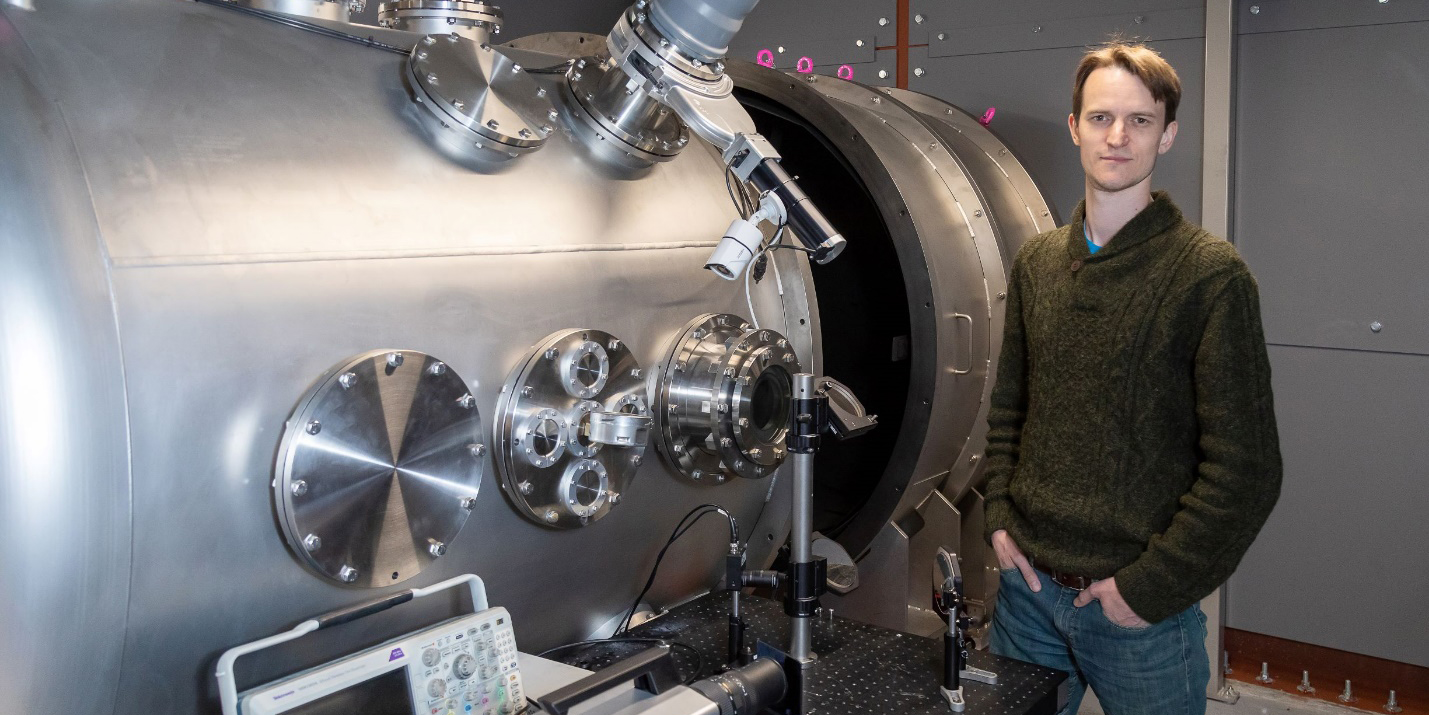Rare quasicrystal found in Trinity test debris

The world’s first atomic bomb test—code-named Trinity and conducted in New Mexico on July 16, 1945—had an unintended outcome that was only recently discovered.

A message from NV5, Inc.
Seconds Matter: Rethinking Nuclear Facility Security for the Modern Threat Landscape

The world’s first atomic bomb test—code-named Trinity and conducted in New Mexico on July 16, 1945—had an unintended outcome that was only recently discovered.
 Among the 12 energy-mix scenarios analyzed in a new report from the University of Illinois at Urbana-Champaign, maintaining the current Illinois reactor fleet while also investing in advanced nuclear technology and renewable energy is the most economical path to zero carbon for the state. It is also, says the report, the path that generates the lowest lifecycle carbon emissions.
Among the 12 energy-mix scenarios analyzed in a new report from the University of Illinois at Urbana-Champaign, maintaining the current Illinois reactor fleet while also investing in advanced nuclear technology and renewable energy is the most economical path to zero carbon for the state. It is also, says the report, the path that generates the lowest lifecycle carbon emissions.
The 26-page report, Economic and Carbon Impacts of Potential Illinois Nuclear Plant Closures: The Cost of Closures, was coauthored by Kathryn Huff, who was recently appointed principal deputy assistant secretary for nuclear energy at the Department of Energy, along with Madicken Munk, a research scientist in the university’s Nuclear, Plasma, and Radiological Engineering (NPRE) Department, and Sam Dotson, a graduate researcher in NPRE’s Advanced Reactors and Fuel Cycle Analysis group. Financial support for the report was provided by Nuclear Matters.

The Nuclear Regulatory Commission has approved a request by SHINE Medical Technologies for an exemption from regulations on how commercial grade equipment is defined, allowing the company to more easily procure components for the medical isotope production facility it is building in Janesville, Wis.
Nuclear power will remain the dominant source of electricity generation in Bulgaria until 2030, despite the national government’s plans to add a substantial amount of renewable capacity this decade, says GlobalData, a U.K.-based data and analytics company. (According to a national strategy blueprint published on the Bulgarian parliament’s website last year, the country is targeting an additional 2,645 MW of installed capacity from renewable sources by the end of 2030.)
Achieving global carbon neutrality by 2050—a pledge made by well over 100 countries so far, including Canada, the European Union, Japan, the United Kingdom, and the United States—will require investment in new nuclear capacity and the retention of existing nuclear generation, states an open letter released last Friday by the leaders of six prominent nuclear industry organizations.

Gorman

Desbazeille

Arai

Korsnick

Greatrex

Bilbao y Leon
The letter was signed by John Gorman, president and chief executive officer of the Canadian Nuclear Association; Yves Desbazeille, director general of FORATOM; Shiro Arai, president of the Japan Atomic Industrial Forum; Maria Korsnick, president and CEO of the Nuclear Energy Institute; John Greatrex, chief executive of the United Kingdom’s Nuclear Industry Association; and Sama Bilbao y León, director general of the World Nuclear Association.

Traces of freshly made plutonium and radioactive iron recovered from the bottom of the Pacific Ocean are contributing to an understanding of how heavier elements are created from exploding stars and other cosmic events, according to a National Public Radio report.

Inside a new steel-clad facility nicknamed “The Citadel,” First Light Fusion has installed a 22-meter two-stage gas gun—the third-largest such component in Europe.
 Nuclear News magazine has just released the 52nd annual Buyers Guide. This nuclear directory lists more than 600 companies worldwide in 475 business categories used throughout the nuclear community.
Nuclear News magazine has just released the 52nd annual Buyers Guide. This nuclear directory lists more than 600 companies worldwide in 475 business categories used throughout the nuclear community.
For more than 50 years, this annual directory has been a useful resource for utility professionals and the broader nuclear community to find the products, services, and partners needed for their next project. In addition to industry use, the Buyers Guide (and the monthly issues of Nuclear News) serves the nation’s nuclear engineering programs and are delivered to the 10,000 members of the American Nuclear Society. This special issue helps keep the current and future workforce and industry leaders informed about vendors and their areas of expertise, as well as about the ongoing projects and new innovations and technologies being used throughout all segments of the nuclear industry.

Bostelman
Companies that build advanced nuclear reactors in Nebraska would be eligible for tax incentives should a measure now being considered by that state’s lawmakers, Legislative Bill 84, become law.
Under L.B. 84, sponsored by Sen. Bruce Bostelman (R., 23rd Dist.), a renewable energy firm that uses nuclear energy to produce electricity could take advantage of the ImagiNE Nebraska Act—a business tax incentive program signed into law by Gov. Pete Ricketts in August of last year. The bill adds “nuclear electric power generation” to the act’s list of renewable energy sources qualifying for incentives. (Sources already listed in the act include wind, solar, energy storage, geothermal, hydroelectric, biomass, and transmutation of elements.)

Gianforte

Skees
Montana governor Greg Gianforte last week signed into law H.B. 273, which transfers the power to authorize the construction of nuclear power facilities in the state from the public, via referendum, to the legislature. The new measure overturns the Montana Empowering Voters to Approve Proposed Nuclear Facilities Initiative, which had been on the books since 1978.
Sponsored by Rep. Derek Skees (R., Kalispell), H.B. 273 passed in the Montana Senate on April 15 by a vote of 30–20, following a 68–32 nod from the House in February. Both votes were cast largely along party lines, with Republicans in favor and Democrats opposed.

The National Reactor Innovation Center (NRIC) wants to hear from developers and end users interested in integrated energy systems for advanced reactors. Battelle Energy Alliance (BEA), the managing and operating contractor for Idaho National Laboratory, has issued a call for Expressions of Interest for a potential multi-phase demonstration program for innovative uses of nuclear energy, to be carried out by NRIC and the Crosscutting Technology Development Integrated Energy Systems (CTD IES) program. The final date for responses is May 21.
The Canadian Nuclear Association (CNA) last week announced that it has signed a memorandum of understanding with the North American Young Generation in Nuclear (NAYGN) to work together to advocate for initiatives that support STEM and the promotion of nuclear science, energy, and technology. Signed earlier this year by CNA president and chief executive officer John Gorman and NAYGN president Amber Von Ruden, the MOU also calls for collaboration on initiatives to recruit and attract students to nuclear.

Huff
Kathryn D. "Katy" Huff, an assistant professor of nuclear engineering at the University of Illinois at Urbana-Champaign (UIUC), has joined the Department of Energy’s Office of Nuclear Energy as principal deputy assistant secretary, the DOE announced today. Huff will also take on the title of acting assistant secretary.
Called to serve: Just after she was officially sworn in, Huff took to Twitter to break the news:
“I’m thrilled to finally share that today is my first day in the Department of Energy’s Office of Nuclear Energy,” she said. “I’m honored that the Biden-Harris administration has called me to serve . . . during a crucial time in humanity's endeavors toward sustainability, re-imagination of our energy infrastructure, and centering of environmental and energy justice in technology policy. . . . In this position, I hope to work across institutional and other barriers, listen to many voices, strive boldly, and serve responsibly.”

The United States is embarking on a new coordinated federal low-dose radiation research program. With guidance from the National Academies of Sciences, Engineering, and Medicine, the Department of Energy’s Office of Science will build a program that integrates the research of past decades, but without treading the same well-worn path. Instead, the new program will focus on how the scientific understanding of low-dose radiation can best be augmented, applied, and communicated.

The Tennessee Valley Authority and nuclear technology and engineering company Kairos Power this morning announced plans to collaborate on the deployment of the latter’s low-power demonstration reactor, dubbed Hermes, at the East Tennessee Technology Park (ETTP) in Oak Ridge, Tenn. TVA will provide engineering, operations, and licensing support to help Kairos with deployment, according to the announcement.

The Nuclear Regulatory Commission has approved Dominion Energy’s application to renew the Surry nuclear power plant’s operating licenses for an additional 20 years. The renewed licenses authorize the extension of reactor operation at the two-unit plant from 60 to 80 years.

Pritzker
The office of Illinois governor J. B. Pritzker last week unveiled an ambitious energy plan for the state that includes limited subsidies for the financially ailing Byron and Dresden nuclear plants. (In August 2020, Exelon Generation announced that the two Illinois facilities would close this year—Byron in September and Dresden in November—without some form of compensation from the state, due to “market rules that favor polluting power plants over carbon-free nuclear energy.”)
The new plan, dubbed the Consumers and Climate First Act, calls for achieving 100 percent clean energy generation in Illinois by 2050 and recognizes nuclear as a means toward that end. “In the near term, the closure of nuclear plants in Illinois is likely to result in a generation gap that will be filled by dirty energy, namely fossil fuels,” the act states, adding that any support for nuclear should be “short-term and based on clearly demonstrated need.”
 Peter Lyons, former Nuclear Regulatory Commission commissioner (2005–2009) and assistant secretary of energy for nuclear energy (2011–2015), has passed away.
Peter Lyons, former Nuclear Regulatory Commission commissioner (2005–2009) and assistant secretary of energy for nuclear energy (2011–2015), has passed away.
American Nuclear Society President Mary Lou Dunzik-Gougar and executive director/CEO Craig Piercy issued the following statement on May 3:
“We are saddened to hear about the death of Peter Lyons. An ANS fellow and member since 2003, Pete will be remembered for his inspiring leadership and distinguished public service career that spanned five decades. His legacy and vision for a nuclear renaissance will continue to inspire future generations of nuclear professionals. Our thoughts today are with his family and loved ones.”

The disturbingly long list of U.S. nuclear plants prematurely closed in recent years will get even longer tonight when the last reactor at the Indian Point Energy Center, Unit 3, powers down for the final time. The shutdown, scheduled for 11 p.m. local time, will mark the end of nearly 60 years of zero-carbon electricity generation at the Buchanan, N.Y., facility.

New Jersey’s Board of Public Utilities (BPU) yesterday voted unanimously to extend, for an additional three years, the zero emission certificate (ZEC) program benefitting the state’s two operating nuclear power plants, Hope Creek and Salem. The two facilities produce more than 90 percent of New Jersey’s carbon-free electricity and about 40 percent of its overall power.